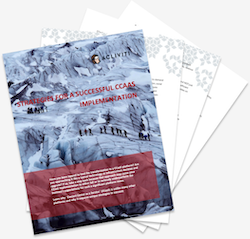Contact center transformation is a growing strategy for modernizing the traditional call center – upgrading solutions, integrating apps, and leveraging new technologies to improve operations and customer satisfaction.
However, call center transformation can have a variety of different interpretations. Depending on who you talk to, it could be as simple as integrating a new channel like SMS into the existing contact center framework: or as complicated as building an entirely new cloud-based infrastructure and new processes for organization-wide business results.
To make sure your contact center as a service (CCaaS) strategy will get you the results you’re looking for now and in the future, consider which capabilities your contact center will actually need – not just now, but what you might need 6 months or three years down the line. Consider future-proofing your contact center with technological capabilities and re-evaluating needs early and often.
Separate CCaaS features and functions into two categories: Critical vs. Nice-to-Have.
The purpose of a CCaaS solution is to efficiently connect brand and customer – offering a consistent, connected experience on the customer’s preferred channel, or across multiple channels and contacts. But bundled in this purpose are a number of considerations, each representing a choice that must be made when building your contact center transformation strategy: is this aspect worth the investment?
Strategies for a Successful CCaaS Implementation
Get the Whitepaper
Contact center transformation considerations include:
1. Dynamic process orchestration
Contact centers can be designed to deliver a planned customer service experience – one that is tested and optimized to improve conversions and drive results. Traditional call centers offer static reporting and views – offering a snapshot of a single point in time. CCaaS offers dynamic processes that adapt and fluctuate across the timeline. CCaaS helps businesses deliver on promises of consistency and brand messaging across all interactions.
Related reading: Navigate Contact Center as a Service (CCaaS) Transformation with Confidence
CCaaS process organization capabilities should be channel-agnostic, sharing accurate information in real time, and have options for intelligent self-service. Process orchestration within contact center modernization provides tools to manage increasingly complex customer interactions.
Process orchestration tools may include:
-
- Omnichannel experience integration
- SMS / text
- Voice
- Chatbot
- Website
- Other
- Voice biometrics
- Intelligent voice response
- Automated call distribution
- Skills-based routing
- Last / preferred agent routing
- Customer self-service opportunities
- AI-driven virtual assistants
2. Workforce Management
One of the main drivers of a large-scale contact center transformation is improving workforce management. This may include performance measurement and monitoring, workforce planning, and compliance.
An emerging challenge driving CCaaS adoption is the use of workforce management (WFM) tools for omnichannel resource allocation. For the past 20 years, WFM tools have focused on voice call agents. But today, with the rapid shift to chat, SMS, and other digital channels, WFM tools are evolving to accommodate these new communications methods as well.
Workforce management tools to consider include:
- Call recording
- Speech & text analytics
- Automated coaching
- Customer satisfaction solutions
- Forecasting labor needs
- Scheduling
- Shift changes / breaks
- Quality Assurance
- Other
3. Security and Compliance
One of the main benefits of contact center transformation is the fact that the vendor takes on responsibility for managing security, compliance, maintenance, and system updates. It is critical that a comprehensive CCaaS strategy includes considerations for security and compliance including:
Security and compliance capabilities to consider are:
- Data security
- Encryption in transit and at rest
- Accreditation
- Cybersecurity Protocols
- Compliance
- Integrations
- Other
Technology Vendor Selection Strategies
Within each of these categories, there will be considerations for call center transformation that a business should review in great detail. Your company’s priorities will be tied directly to the objectives of the CCaaS modernization project. Which KPIs will be measured? What does a successful transformation look like for your company? Who will benefit from the transformation, and how? Understanding how a call center transformation affects the entire organization is critical, and building organizational alignment can be difficult.
Each of these will affect the level of exploration needed, and the distribution of resources across the CCaaS solution. If you are considering transforming your contact center, and finding a partner (or partners) to implement contact center as a service, ACLIVITI can help. Whether you are just beginning to consider CCaaS benefits, or if you are already in the process of transformation, leverage our expertise to make the right decision for your organization and shorten the time to value realization.














